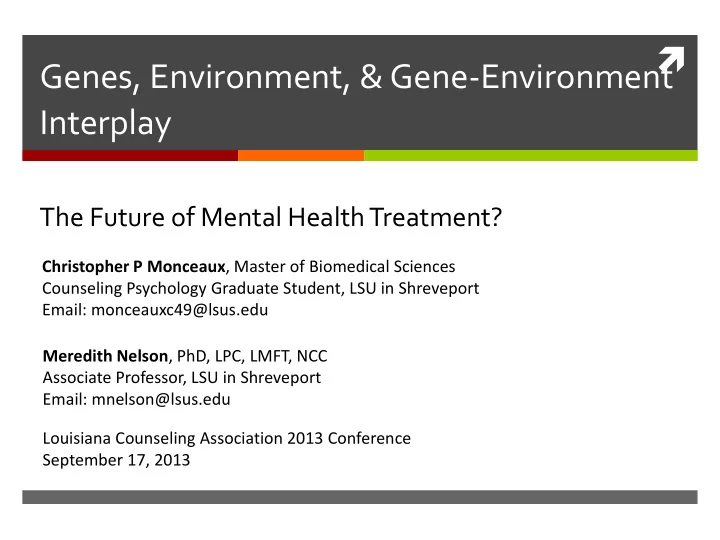

Genes, Environment, & Gene-Environment Interplay The Future of Mental Health Treatment? Christopher P Monceaux , Master of Biomedical Sciences Counseling Psychology Graduate Student, LSU in Shreveport Email: monceauxc49@lsus.edu Meredith Nelson , PhD, LPC, LMFT, NCC Associate Professor, LSU in Shreveport Email: mnelson@lsus.edu Louisiana Counseling Association 2013 Conference September 17, 2013
Outline Biology of Mental Health Environmental Effects on Mental Health Gene-Environment Interplay Mental Health Treatment Implications http://psychcentral.com/news/u/2010/06/dna-man-abstract.jpg
The Biology of Mental Health
Central Dogma of Molecular Biology DNA RNA Protein What is a gene?
Mutations “Heritable change in the nucleotide sequence of a chromosome” ( Alberts et al., 2002, p. G:23). What causes changes in the DNA sequence? Spontaneous changes of bases Reactive metabolites Environmental chemicals UV radiation Recombination http://mthfr.net/mthfr-mutations-and-the-conditions-they-cause/2011/09/07/
Molecular Biology & Mental Health Genetic mutations and dysfunctional cellular signaling play some role in the etiology of disorders Schizophrenia ADHD Mood disorders Anxiety disorders & PTSD The genetic and signaling components of mental health often overlap, including multiple genes and signaling pathways. http://blogs.scientificamerican.com/observations/2010/05/10/schizophrenia-shares-genetic- links-with-autism-genome-study-shows/
Environmental Effects on Mental Health
Gene-Environment Interplay
What exactly is gene-environment interplay? Three categories (Brendgen et al., 2009; Rutter, Moffitt, & Caspi, 2006) Interaction between specific genes and environment (GXE) Epigenetics Gene-environment correlations (rGE)
Gene-Environment Interactions Works via three mechanisms (Brendgen et al., 2009) Diathesis-stress Compensation Control Evidence/Examples Anxiety and depressive disorders (Petersen et al., 2012) Schizophrenia (van Winkel et al., 2010)
Epigenetics DNA RNA Protein Regulations above the level of genetic code lead to alterations in gene expression Exposure to certain environments can change the regulation (Champagne & Mashoodh, 2009) http://www.medscape.com/viewarticle/772252_5
Epigenetics (Ctd) Nucleus Cytoplasm Inactive mRNA 5 1 2 3 RNA mRNA DNA mRNA transcript 4 Inactive protein 1. Transcriptional Control protein 6 2. RNA Processing Control 3. RNA Transport & Localization Control 4. Translation Control 5. mRNA Degradation Control 6. Protein Activity Control
Gene-Environment Correlations (rGE) Parent’s Genes Exposure to Particular Environments Individual’s Genes Three types: Passive, Active, & Evocative (Rutter, Moffitt, & Caspi, 2006)
Interplay Between Different Types Different types of gene- environment interplay can occur at the same time Example Peer acceptance/rejection and depressive behavior (Brendgen et al., 2009)
Resilience Genetics Environment Gene-environment interplay http://cognitive-edge.com/blog/entry/5873/cynefin-strategy-building-resilience/
Implications for Counseling/Mental Health Treatment
Implications for Treatment Main clinical benefit will likely be from an understanding of the biological pathways of the interactions (Rutter, 2010). Once understood, drug treatments could be used for environmentally insensitive individuals and psychotherapy used for environmentally sensitive individuals (Rutter, 2010). Understanding the form of gene- environment interplay at work in a disorder could help pick prevention and intervention strategies (Jaffee & Price, 2007). Overall, will help to further tailor the treatment to each individual. http://www.prevention.com/health/healthy-living/dna-testing-genetic-diseases
Ethical Considerations Fatalism Privacy and confidentiality Environmental conditions
Hope or Hype Epigenetics is not “all or none.” Depends on many factors, including cell type, differentiation, etc. Changeable http://www.proginosko.com/2013/01/the-most-important-question/
Changes in Classification NIMH Research Domain Criteria Project “facilitate translation of modern molecular biology, neuroscience, and behavioral approaches toward explicating the pathophysiology of disorders (Cuthbert & Insel, p. 1062)” http://www.ipgcounseling.com/blogs/margie-nichols/dsm-and-nimh- why-insel-got-it-right-and-what-it-means-sexology
Conclusions
Conclusions Both genes and the environment play an important role in mental health. One mechanism by which this may take place is gene- environment interplay. Interplay can occur in different forms that may often be at work together. Learning more about these interactions could lead to the development of tailored treatment options.
References & Recommended Readings Alberts, B., Johnson, A., Lewis, J., Raff, M., Roberts, K., & Walter, P. (2002). Molecular Biology of the Cell . (4 th ed.). New York: Garland Science. Bagdy, G., Juhasz, G., & Gonda, X. (2012). A new clinical evidence-based gene-environment interaction model of depression. Neuropsychopharmacologia Hungarica: a Magyar Pszichofarmakológiai Egyesület lapja = official journal of the Hungarian Association of Psychopharmacology , 14 (4), 213 – 220. Brendgen, M., Vitaro, F., Boivin, M., Girard, A., Bukowski , W. M., Dionne, G.,… Perusse, D. (2009). Gene-environment interplay between peer rejection and depressive behavior in children. Journal of Child Psychology and Psychiatry, 50 (8), 1009-1017. doi: 10.1111/j.1469-7610.2009.02052.x Champagne, F. A., & Mashoodh, R. (2009). Genes in context: gene-environment interplay and the origins of individual differences in behavior. Current Directions in Psychological Science, 18 (3), 127-131. Craddock, N., & Sklar, P. (2013). Genetics of bipolar disorder. Lancet , 381 (9878), 1654 – 1662. doi:10.1016/S0140-6736(13)60855-7 Doherty, J. L., O’Donovan, M. C., & Owen, M. J. (2012). Recent genomic advances in schizophrenia. Clinical genetics , 81 (2), 103 – 109. doi:10.1111/j.1399-0004.2011.01773.x Heinrich, A., Nees, F., Lourdusamy, A., Tzschoppe, J., Meier, S., Vollstädt- Klein, S., … The IMAGEN consortium. (2013). From gene to brain to behavior: schizophrenia -associated variation in AMBRA1 alters impulsivity-related traits. The European journal of neuroscience . doi:10.1111/ejn.12201 Ikegame, T., Bundo, M., Murata, Y., Kasai, K., Kato, T., & Iwamoto, K. (2013). DNA methylation of the BDNF gene and its relevance to psychiatric disorders. Journal of human genetics . doi:10.1038/jhg.2013.65 Jaffee, S. R., & Price, T. S. (2007). Gene-environment correlations: a review of the evidence and implications for prevention of mental illness. Molecular Psychiatry, 12 , 432-442. Kim-Cohen, J., & Gold, A. L. (2009). Measured Gene – Environment Interactions and Mechanisms Promoting Resilient Development. Current Directions in Psychological Science (Wiley-Blackwell) , 18 (3), 138 – 142. doi:10.1111/j.1467-8721.2009.01624.x Klengel, T. (2013). Gene-Environment Interactions in Major Depressive Disorder. Interactions gène-environnement dans le trouble dépressif majeur. , 58 (2), 76 – 83. Logue, M. W., Solovieff, N., Leussis, M. P., Wolf, E. J., Melista , E., Baldwin, C., … Miller, M. W. (2013). The ankyrin -3 gene is associated with posttraumatic stress disorder and externalizing comorbidity. Psychoneuroendocrinology . doi:10.1016/j.psyneuen.2013.04.013
Recommend
More recommend